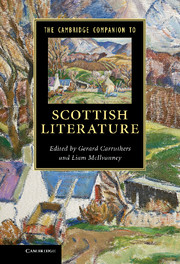Book contents
- Frontmatter
- Contents
- Notes on Contributors
- Acknowledgements
- Chronology
- Introduction
- 1 Scottish Literature before Scottish Literature
- 2 The Medieval Period
- 3 Reformation and Renaissance
- 4 The Aftermath of Union
- 5 Robert Burns
- 6 Enlightenment, Romanticism and the Scottish Canon
- 7 Scott and the Historical Novel
- 8 The Gaelic Tradition
- 9 Scottish Gothic
- 10 Victorian Scottish Literature
- 11 Robert Louis Stevenson
- 12 Hugh MacDiarmid and the Scottish Renaissance
- 13 Popular Fiction
- 14 Muriel Spark
- 15 The Glasgow Novel
- 16 ‘What is the language using us for?’
- 17 The Emergence of Scottish Studies
- 18 Otherworlds
- 19 Scottish Literature in Diaspora
- Index
- References
13 - Popular Fiction
Detective Novels and Thrillers from Holmes to Rebus
Published online by Cambridge University Press: 05 January 2013
- Frontmatter
- Contents
- Notes on Contributors
- Acknowledgements
- Chronology
- Introduction
- 1 Scottish Literature before Scottish Literature
- 2 The Medieval Period
- 3 Reformation and Renaissance
- 4 The Aftermath of Union
- 5 Robert Burns
- 6 Enlightenment, Romanticism and the Scottish Canon
- 7 Scott and the Historical Novel
- 8 The Gaelic Tradition
- 9 Scottish Gothic
- 10 Victorian Scottish Literature
- 11 Robert Louis Stevenson
- 12 Hugh MacDiarmid and the Scottish Renaissance
- 13 Popular Fiction
- 14 Muriel Spark
- 15 The Glasgow Novel
- 16 ‘What is the language using us for?’
- 17 The Emergence of Scottish Studies
- 18 Otherworlds
- 19 Scottish Literature in Diaspora
- Index
- References
Summary
Scottish writers have, at times, played a role in detective, adventure and thriller writing that is out of proportion to the size of the nation. Though Scotland played no significant part in the twentieth-century’s so-called ‘Golden Age’ of crime fiction, which was dominated by English and American authors, its writers were influential in establishing the genre in the late nineteenth century and can, in the early twenty-first century, count among themselves some of its most popular global practitioners. This chapter may not be able to offer a satisfactory explanation of why this is the case – unfortunately, literary criticism is rarely as tidy as fictional detective work – but it will offer an account of the somewhat punctuated evolution of crime and thriller fiction in the Scottish context in the period that runs from Conan Doyle to so-called Tartan Noir.
Arthur Conan Doyle and Robert Louis Stevenson are Scottish writers who demand attention principally because of the impact their work had on a popular writing based on action and suspense, on psychological instability and the solving of puzzles. Conan Doyle’s place in the history of detective fiction needs little elaboration. Though he took up a genre that had been established in the 1830s and 40s by Vidocq’s Mémoires, the Newgate novels and Edgar Allan Poe’s Dupin stories, and which had been experimented with variously by Charles Dickens, Wilkie Collins, Mary Elizabeth Braddon and, most successfully, by Émile Gaboriau, Conan Doyle established in the popular mind the type of the detective story in its modern form. In his Sherlock Holmes stories for the Strand magazine from 1891 and in novellas such as A Study in Scarlet (1887), The Sign of Four (1890) and The Hound of the Baskervilles (1902), Conan Doyle created a fiction that fed on the sensational elements of his predecessors’ work, featuring luminescent hellhounds bounding out of moorland mist, diabolical master criminals and dark deeds in opium dens. But it kept that sensationalism tightly bound in satisfying plots that, through Holmes’s reasoned application of observation, analysis and deduction, reduced the seemingly uncanny to the reassuringly explicable.
- Type
- Chapter
- Information
- The Cambridge Companion to Scottish Literature , pp. 188 - 202Publisher: Cambridge University PressPrint publication year: 2012
References
- 3
- Cited by

